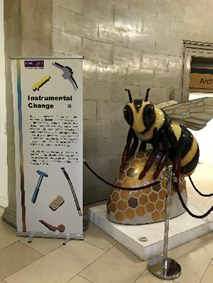Reflections on Instrumental Change
- Gemma Burns & Amy Harris
- Dec 14, 2019
- 2 min read
Instrumental Change was a one-day pop-up exhibition curated by MA Art Gallery and Museum Studies students from the University of Manchester. The exhibition used objects from the Museum of Medicine and Health's collections to explore the evolution, functionality and sustainability of different medical materials.
Instrumental change discussed extremely relevant contemporary issues, such as material sustainability, the health of the planet versus the health of an individual and NHS funding for more expensive yet more eco friendly materials. Questions were asked about the future of medicine, the place of different materials within the medical field and how, we as a society, can work towards creating a functional, sustainable and evolved health service that is capable of benefiting the general population and the planet.
There is no denying that the creation of the exhibition was a difficult task. With over 30 students making up 12 separate groups, all with differing responsibilities the collaborative process was not always easy. Yet, every single student contributed with enthusiasm to make an exhibition that could truly engage the public. In order to do this, we were originally divided into 6 groups to take responsibility for 6 different types of materials. The materials being: ceramic, natural materials (such as ivory), metal (one group taking more traditionally used metals such as copper and the other taking more complex metals such as titanium), plastic and disposables. With these materials, we were able to link each miniature exhibition to create one cohesive narrative- the materials really telling their own stories and taking the visitor on a journey through time and medical practices.
One of the best parts of the exhibition was seeing people truly engage with what they were seeing, even if it was in an unconventional way. From playing ‘material Top Trumps’ to trying their hand at using a skin stapler, people seemed to genuinely enjoy their time and went away having learnt something new. Visitors throughout the day had been asking as many questions as they could. A memorable interaction with a visitor centred around the doctor John Charnley, who invented to the Total Hip Replacement (THR). The visitor had been a nurse before she retired and became very animated when she recognised Charnley as a man she had studied. She proceeded to ask about how Charnley’s designs were still being used today having not realised that his model for the THR was still widely in use around the world. The enthusiasm displayed by this visitor was everything the exhibition team could have hoped for and this was just one of the many enthusiastic interactions that contributed to the overall positive atmosphere.
There was a general consensus from visitors and within the team that the exhibition had done well as we had a steady footfall, with over 100 visitors attending throughout the day. Every step of the process, from checking the condition of the objects to formatting text in a visitor friendly way to exhibition installation was a fantastic opportunity for the MA students involved. Instrumental Change was also influential in expanding the Museum of Medicine and Health’s visitor demographics, exposing their collections, as well as enhancing the museums reputation as Instrumental Change encouraged contemporary debates.
Written by Amy Harris






Comments